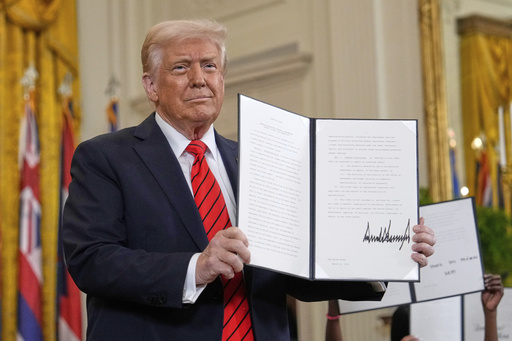President Donald Trump’s directive to dismantle the U.S. Education Department brings a host of complicated consequences. Trump contends that the federal department has not contributed to better student outcomes and argues that it is redundant in a system where education is predominantly managed at the state and local levels, from funding allocations to hiring decisions and curriculum development.
For years, right-wing proponents have voiced their desire to do away with the agency, established by Congress in 1979. As Trump reshapes the federal landscape, he voices criticism toward the department, deeming it a wasteful entity responsible for encouraging “woke” ideologies. These include initiatives promoting diversity, equity, and inclusion, as well as safeguarding the rights of transgender students. Historically, the department has played a key role in supervision, enforcing anti-discrimination laws, and allocating aid to schools serving low-income and disabled students. Federal funding, though, constitutes only about 14% of public school budgets.
Considering the implications of Trump’s order on children and educators, immediate changes are unlikely to be felt by students, teachers, and parents. However, the long-term effects remain difficult to predict and largely depend on how Education Secretary Linda McMahon navigates redistributing the department’s functions to other governmental bodies, including state governments.
A key concern centers around how states will manage federal funding that aids in educating impoverished, disabled, or English language-learning students. Many school districts, especially those in rural areas or with weaker property tax revenues, rely on this funding to cover expenses like teacher salaries, transportation, and educational technology. States like Mississippi and Alaska are particularly dependent on this support, which can cover over 20% of their education spending. Advocates fear that without federal oversight, funds could be redirected towards initiatives like private school vouchers.
Regarding student loans, although the Trump administration has cut back personnel and contracts essential for operating the Free Application for Student Aid (FAFSA) and assisting users with the complex process, McMahon assures that essential federal programs will persist. Recently, Trump announced that the Small Business Administration would manage the $1.6 trillion federal student loan portfolio. Some conservatives, including previous Education Secretary Betsy DeVos, have proposed creating a semi-private banking system for loan distribution. Developers of the StudentAid.gov platform face challenges, as evidenced by a site outage that occurred while remaining staff worked to resolve technical disruptions.
School meal programs, funded by the Department of Agriculture, stand unaffected by Trump’s plan to shutter the Education Department. However, the USDA has withdrawn a $1 billion pandemic-era initiative that supported schools and food banks in purchasing fresh local produce.
The timeline for the potential dismantlement of the department hinges on numerous variables. Multiple states and organizations are prepared to file lawsuits, likely delaying the process. Entirely dissolving the department would require legislative action by Congress. While Republican lawmakers plan to propose legislation for dismantling the agency, they are expected to encounter significant resistance from Democrats.
Even amid efforts to eliminate the department, Trump envisions an active role for it in identifying and penalizing schools that maintain diversity, equity, and inclusion initiatives.



